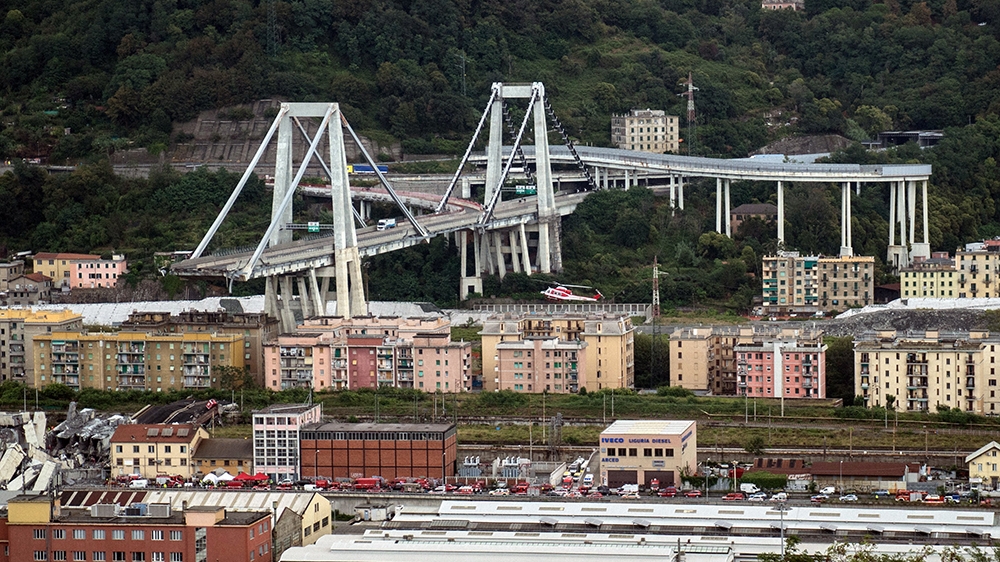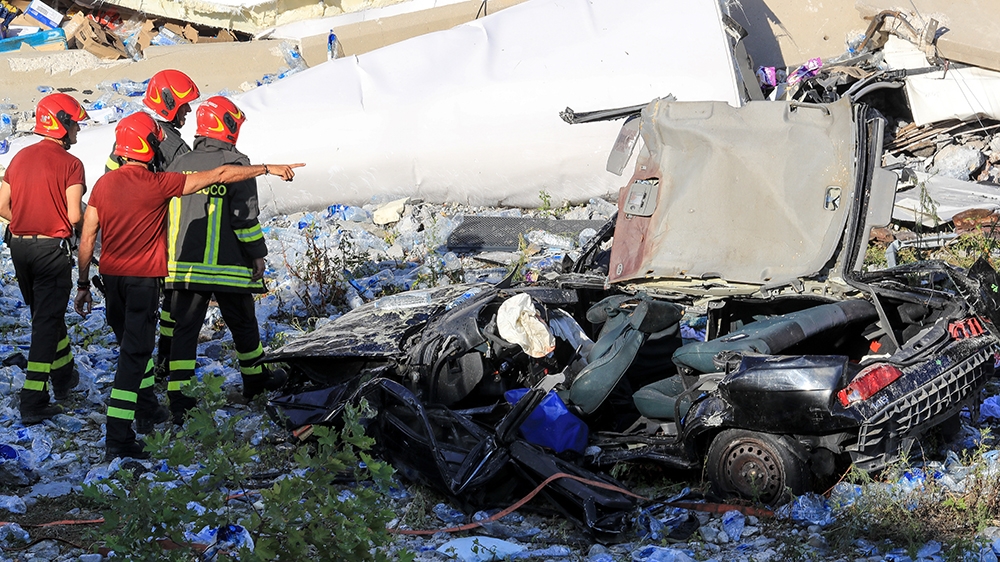Italy bridge: 38 dead as rescuers search for survivors
The death toll in a major bridge collapse reached 38 in Italy and could rise further on Wednesday as rescue teams searched the vast concrete debris for any survivors.
A 50-metre section of the Morandi bridge – part of a toll highway and one of the main arteries into the port city of Genoa – collapsed at about 12pm local time on Tuesday, taking down with it about 35 cars and three trucks that had been crossing at the time.
Huge slabs of reinforced concrete plunged onto two warehouses, train tracks and a riverbed
“We’re currently at 38 confirmed deaths and some people missing,” said Interior Minister Matteo Salvini.
Three people were missing and about a dozen remained hospitalised in serious condition, authorities said.
According to Italy’s civil protection department, about 1,000 police, firefighters and volunteers were deployed to the scene.
The head of Genoa’s public prosecutor’s office, Francesco Cozzi, said he was ready to “open a file for negligent multiple homicide and disaster”, and it would be against unknown persons “because the reasons for the tragedy are still unknown”.
 |
| Prime Minister Giuseppe Conte, centre, visits the site [Federico Scoppa/AFP] |
Italy’s transport minister ordered safety checks of all major infrastructure across the country. Danilo Toninelli also called on Wednesday for senior managers to resign at the company operating the bridge.
The government will also look into stripping Autostrade per l’Italia, a unit of the Atlantia group, of the concession to manage the motorway that included the Morandi Bridge, and imposing financial penalties on the group, Toninelli said.
Atlantia and Autostrade per l’Italia could not immediately be reached for comment
The Morandi bridge was built in the 1960s on the A10 toll motorway connecting Genoa to French border.
“Autostrade per l’Italia was not able to fulfill its obligations under the contract regulating management of this infrastructure,” Toninelli said on RAI 1 state television.
Evacuations
Houses in the immediate vicinity have been evacuated out of fear that the two remaining sections of the bridge would also give way.
“I heard a rumble and I fell down,” a surviving truck driver told the Italian daily Corriere della Sera.
The man, who was seen walking with his arm bandaged after suffering a shoulder sprain and some minor wounds, was still in shock when cameras approached him near the scene. “I was in front of the truck, when I flew away like everything else. My truck is buried.”
A footballer, Davide Capello, who had been driving on the bridge, said it was a miracle he was still alive.
“I saw the road collapse in front of me and I started falling with it. I was lucky,” he said. “I didn’t black out, I immediately called firefighters to come and get me.”
 |
| A view of the Morandi motorway bridge after a section collapsed [Federico Scoppa/AFP] |
The reasons for the collapse have not yet been established.
“Now is the time for a common commitment in order to face the emergency, assist the wounded, support those who are mourning,” President Sergio Mattarella said in a statement. “Then a serious investigation into the causes of what happened [is needed]. No authority can evade full responsibility.”
The 1,182-metre structure was inaugurated in 1967 and went through major reinforcement work in the 1990s.
Ansa news agency cited a 2011 report by Autostrade per l’Italia as saying the bridge had been suffering from decay.
“Queues of cars and the volume of traffic provoke intense decay of the Morandi viaduct structure on a daily basis in the rush hours as it is subject to major demands,” the report said, adding the bridge was for this reason in need for continuous maintenance work.
Il Sole 24 Ore, Italy’s financial newspaper, reported the company had launched a 20-million euro call for tenders in April 2018 for “structural retrofitting” of the bridge.
 |
| Italian rescuers search the scene of the collapsed Morandi motorway bridge to look for victims and survivors in the northern port city of Genoa [Valery Hache/AFP] |
A bystander, Pietro M, told Ansa he saw “lightning strike the bridge” just before the collapse, as a wave of bad weather was sweeping through Italy at the time.
Transport Minister Toninelli said in a TV interview “the first major intervention by this government will be to carry out ordinary maintenance of the infrastructure that already exists”.
Salvini said he wanted “names and surnames of those responsible”, adding austerity measures imposed by the European Union may have led to budget cuts that caused local authorities to save on maintenance costs.




